What’s Up For November 2016
What’s Up for November 2016
What’s Up for November: Venus at sunset, Jupiter at dawn, your last evening glimpse of Saturn until spring, and more meteors!

Through November 3, catch glimpses of a gibbous Venus, a crescent moon and ringed Saturn in the southwest sky just after sunset.

Wake up before sunrise every day this month to see Jupiter just above Spica, the brightest star in the constellation Virgo, shining in the east-southeast sky.
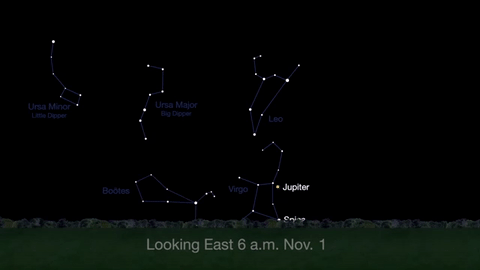
Just before dawn on November 23-24, see the waning crescent moon just above Jupiter.
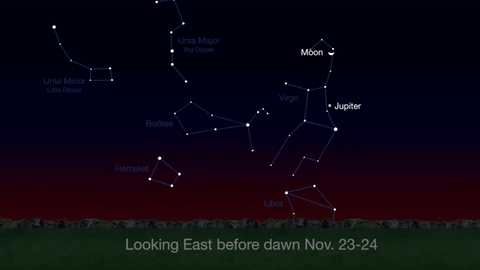
November is a great time to see the constellation Ceres as it glides past Cetus, the Whale and you will be able to see the dwarf planet move relative to the background stars, but you’ll need a telescope for this one.
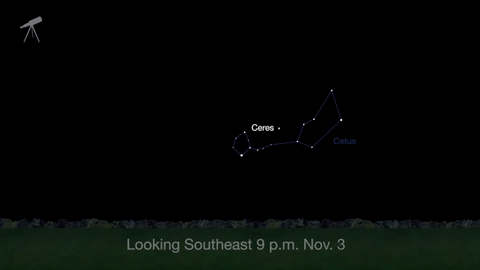
This month, just like last month, there will be three meteor showers--the Northern Tuarids, the Leonids and the November Orionids.
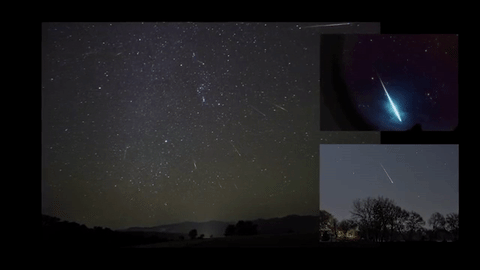
Watch the full November “What’s Up" video for more:
Make sure to follow us on Tumblr for your regular dose of space: http://nasa.tumblr.com.
More Posts from Nasa and Others
Applying Earth Observations Data to the Real World
In our DEVELOP Program, participants work on Earth science research projects and are mentored by science advisors from within the agency and from partner agencies, and extend research results to local communities.
This year, our partners ran the gamut from NASA centers to The National Oceanic and Atmospheric Agency (NOAA) to the University of Georgia to state and local governments. The one thing all have in common: using data from our Earth-observing satellites to inform such topics as disaster relief, preserving watershed and marshlands, working municipalities to provide health and study. The program also helps future scientists develop research and presentation skills.
Annually, the participants gather at NASA Headquarters to present their findings. From more than two dozen, we’re highlighting a cross section whose projects covered climate and invasive species in Alaska; health and air quality in Las Cruces; disaster preparation in the Philippines; and air quality in the Shenandoah Valley.
The projects demonstrate to community leaders how our science measurements and predictions can be used to address local policy issues. This year, DEVELOP features more than two dozen projects covering Earth science topics from all corners of the globe.
DEVELOP projects apply Earth observations to agriculture, climate, disasters, ecological forecasting, energy, health and air quality, oceans, water resources and weather. These projects highlight NASA Earth observation capabilities relative to environmental issues and concerns for enhanced policy and decision-making to improve life here on Earth.
DEVELOP projects apply Earth observations to agriculture, climate, disasters, ecological forecasting, energy, health and air quality, oceans, water resources and weather. These projects highlight NASA Earth observation capabilities relative to environmental issues and concerns for enhanced policy and decision-making to improve life here on Earth.
Visit the Develop Project page to learn more about the program and how to apply.
Make sure to follow us on Tumblr for your regular dose of space: http://nasa.tumblr.com
Solar System: Things to Know This Week
Learn about the science of photonics to create space communications, get updates on Juno, mining data from Voyager for new discoveries and more.

1. Carried on a Beam of Light
One of our major priorities is to make space communications more efficient. While our communications systems have matured over the decades, they still use the same radio-frequency system developed in the earliest days of the agency. After more than 50 years, we’re investing in new ways to increase data rates while also finding more efficient communications systems. Photonics--generating, detecting and manipulating particles of light--may provide the solution.
+ See how it works

2. It's No Joke: Two New Moons for the Seventh Planet
Voyager 2 spacecraft flew by Uranus 30 years ago, but researchers are still making discoveries using the data it gathered. A new study led by University of Idaho researchers suggests there could be two tiny, previously undiscovered moonlets orbiting near two of the planet's rings.
+ Find out how they were discovered

3. Vortex of Mystery
As southern winter solstice approaches in the Saturn system, our Cassini spacecraft has revealed dramatic seasonal changes in the atmospheric temperature and composition of Saturn's largest moon, Titan. Winter is taking a grip on Titan's southern hemisphere, and a strong, whirling vortex has intensified in the upper atmosphere over the south pole.
+See more

4. The Spiders of Mars
Ten thousand volunteers viewing images of Martian south polar regions have helped identify targets for closer inspection, yielding new insights about seasonal slabs of frozen carbon dioxide and erosional features known as "spiders." From the comfort of home, the volunteers have been exploring the surface of Mars by reviewing images from the Context Camera on our Mars Reconnaissance Orbiter and identifying certain types of seasonal terrains near Mars' south pole.
+ Learn more and see how you can join in

5. Better Safe Than Sorry
On Oct. 18, when Juno’s onboard computer entered safe mode, early indications were a software performance monitor induced a reboot of the spacecraft's onboard computer, turning off instruments and a few non-critical spacecraft components, and it confirmed the spacecraft was pointed toward the sun to ensure the solar arrays received power. On Oct. 24, the spacecraft left safe mode and has successfully completed a minor burn of its thruster engines in preparation for its next close flyby of Jupiter. The team is still investigating the cause of the reboot and assessing two main engine check valves. The burn, which lasted just over 31 minutes, changed Juno’s orbital velocity by about 5.8 mph (2.6 meters per second) and consumed about 8 pounds (3.6 kilograms) of propellant. Juno will perform its next science flyby of Jupiter on Dec. 11, with time of closest approach to the gas giant occurring at 12:03 p.m. EDT. The complete suite of Juno’s science instruments, as well as the JunoCam imager, will be collecting data during the upcoming flyby.
+ Get the details
Discover the full list of 10 things to know about our solar system this week HERE.
Make sure to follow us on Tumblr for your regular dose of space: http://nasa.tumblr.com
Solar System: Things to Know This Week
The Quadrantid meteor shower peaked this morning. Here are some fun facts:

1. Where Is Quadrans Muralis?
The radiant of the Quadrantids lies in the demoted constellation Quadrans Muralis.

2. What Is a Mural Quadrant?
The Mural Quadrant is an angle measuring device mounted on or built into a wall. Quadrans Muralis appears on some 19th-century star atlases between Hercules, Boötes and Draco, and different astronomers changed the stars from time to time.

3. New Constellations
In the early 1920's, the International Astronomical Union divided up the sky into official constellations for consistency in star naming. 88 constellations remained, but over 30 historical constellations, including Quadrans Muralis, didn't make the cut.

4. Where Is It Now?
Most of the Quadrans Muralis stars are now within the boundaries of the official constellation Boötes, but the name of the meteor shower did not change.

5. Where Do Meteor Showers Come From?
Meteor showers are usually the residue that collects in the orbits of comets. Unlike most meteor showers' parent bodies, the Quadrantids are associated with an asteroid—2003 EH1.
Discover the full list of 10 things to know about our solar system this week HERE.
Make sure to follow us on Tumblr for your regular dose of space: http://nasa.tumblr.com
Dark Matter 101: Looking for the missing mass
Here’s the deal — here at NASA we share all kinds of amazing images of planets, stars, galaxies, astronauts, other humans, and such, but those photos can only capture part of what’s out there. Every image only shows ordinary matter (scientists sometimes call it baryonic matter), which is stuff made from protons, neutrons and electrons. The problem astronomers have is that most of the matter in the universe is not ordinary matter – it’s a mysterious substance called dark matter.

What is dark matter? We don’t really know. That’s not to say we don’t know anything about it – we can see its effects on ordinary matter. We’ve been getting clues about what it is and what it is not for decades. However, it’s hard to pinpoint its exact nature when it doesn’t emit light our telescopes can see.
Misbehaving galaxies
The first hint that we might be missing something came in the 1930s when astronomers noticed that the visible matter in some clusters of galaxies wasn’t enough to hold the cluster together. The galaxies were moving so fast that they should have gone zinging out of the cluster before too long (astronomically speaking), leaving no cluster behind.

Simulation credit: ESO/L. Calçada
It turns out, there’s a similar problem with individual galaxies. In the 1960s and 70s, astronomers mapped out how fast the stars in a galaxy were moving relative to its center. The outer parts of every single spiral galaxy the scientists looked at were traveling so fast that they should have been flying apart.

Something was missing – a lot of it! In order to explain how galaxies moved in clusters and stars moved in individual galaxies, they needed more matter than scientists could see. And not just a little more matter. A lot . . . a lot, a lot. Astronomers call this missing mass “dark matter” — “dark” because we don’t know what it is. There would need to be five times as much dark matter as ordinary matter to solve the problem.
Holding things together
Dark matter keeps galaxies and galaxy clusters from coming apart at the seams, which means dark matter experiences gravity the same way we do.

In addition to holding things together, it distorts space like any other mass. Sometimes we see distant galaxies whose light has been bent around massive objects on its way to us. This makes the galaxies appear stretched out or contorted. These distortions provide another measurement of dark matter.
Undiscovered particles?
There have been a number of theories over the past several decades about what dark matter could be; for example, could dark matter be black holes and neutron stars – dead stars that aren’t shining anymore? However, most of the theories have been disproven. Currently, a leading class of candidates involves an as-yet-undiscovered type of elementary particle called WIMPs, or Weakly Interacting Massive Particles.

Theorists have envisioned a range of WIMP types and what happens when they collide with each other. Two possibilities are that the WIMPS could mutually annihilate, or they could produce an intermediate, quickly decaying particle. In both cases, the collision would end with the production of gamma rays — the most energetic form of light — within the detection range of our Fermi Gamma-ray Space Telescope.
Tantalizing evidence close to home
A few years ago, researchers took a look at Fermi data from near the center of our galaxy and subtracted out the gamma rays produced by known sources. There was a left-over gamma-ray signal, which could be consistent with some forms of dark matter.

While it was an exciting finding, the case is not yet closed because lots of things at the center of the galaxy make gamma rays. It’s going to take multiple sightings using other experiments and looking at other astronomical objects to know for sure if this excess is from dark matter.

In the meantime, Fermi will continue the search, as it has over its 10 years in space. Learn more about Fermi and how we’ve been celebrating its first decade in space.
Make sure to follow us on Tumblr for your regular dose of space: http://nasa.tumblr.com.


Whilst practicing solar distancing, Parker Solar Probe caught this rare glimpse of the twin tails on comet NEOWISE.☄
The twin tails are seen more clearly in this WISPR instrument processed image, which increased contrast and removed excess brightness from scattered sunlight, revealing more de-"tails". C/2020 F3 NEOWISE was discovered by our Near-Earth Object Wide-field Infrared Survey Explorer (NEOWISE), on March 27. Since it's discovery the comet has been spotted by several NASA spacecraft, including Parker Solar Probe, NASA’s Solar and Terrestrial Relations Observatory, the ESA/NASA Solar and Heliospheric Observatory, and astronauts aboard the International Space Station.
Make sure to follow us on Tumblr for your regular dose of space: http://nasa.tumblr.com
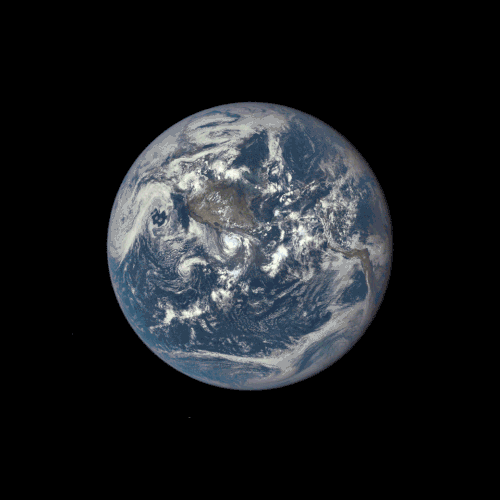
Welcome to the new, official NASA Tumblr. We’re going to be giving you a regular dose of space here. Follow along and join us as we share information, images and video about our mission of exploration and discovery. First up, check out the moon photobombing Earth in this new animated gif. The far side of the moon, illuminated by the sun, is seen as it crosses between our 'EPIC' camera on the Deep Space Climate Observatory (DSCOVR) satellite, and the Earth - one million miles away. Check it out: http://go.nasa.gov/1Dq0IO9
Why Do We Study Ice?
Discover why we study ice and how this research benefits Earth.

We fly our DC-8 aircraft very low over Antarctica as part of Operation IceBridge – a mission that’s conducting the largest-ever airborne survey of Earth’s polar ice.

Records show that 2015 was the warmest year on record, and this heat affects the Arctic and Antarctica – areas that serve as a kind of air conditioner for Earth and hold an enormous of water.

IceBridge flies over both Greenland and Antarctica to measure how the ice in these areas is changing, in part because of rising average global temperatures.
IceBridge’s data has shown that most of Antarctica’s ice loss is occurring in the western region. All that melting ice flows into the ocean, contributing to sea level rise.

IceBridge has been flying the same routes since the mission began in 2009. Data from the flights help scientists better measure year-to-year changes.

IceBridge carries the most sophisticated snow and ice instruments ever flown. Its main instrument is called the Airborne Topographic Mapper, or ATM.The ATM laser measure changes in the height of the ice surface by measuring the time it takes for laser light to bounce off the ice and return to the plane – ultimately mapping ice in great detail, like in this image of Antarctica's Crane Glacier.

For the sake of the laser, IceBridge planes have to fly very low over the surface of snow and ice, sometimes as low as 1,000 feet above the ground. For comparison, commercial flights usually stay around 30,000 feet! Two pilots and a flight enginner manage the many details involved in each 10- to 12-hour flight.

One of the scientific radars that fly aboard IceBridge helped the British Antarctic Survey create this view of what Antarctica would look like without any ice.

IceBridge also studies gravity using a very sensitive instrument that can measure minuscule gravitational changes, allowing scientists to map the ocean cavities underneath the ice edges of Antarctica. This data is essential for understanding how the ice and the ocean interact. The instrument’s detectors are very sensitive to cold, so we bundle it up to keep it warm!

Though the ice sheet of Antarctica is two miles thick in places, the ice still “flows” – faster in some places and slower in others. IceBridge data helps us track how much glaciers change from year-to-year.

Why do we call this mission IceBridge? It is bridging the gap between our Ice, Cloud and Land Elevation Satellite, or ICESat – which gathered data from 2003 to 2009 – and ICESat-2, which will launch in 2018.

Learn more about our IceBridge mission here: www.nasa.gov/icebridge and about all of our ice missions on Twitter at @NASA_Ice.
Make sure to follow us on Tumblr for your regular dose of space: http://nasa.tumblr.com
Apollo 10 Audio — Publicly Available Since 1970s
Recent news articles have reported that “newly declassified” audiotapes reveal that Apollo 10 astronauts heard “outer-spacey” music as the spacecraft flew around the far side of the moon in 1969.
Here are the facts:

While listed as ‘confidential’ in 1969 at the height of the Space Race, Apollo 10 mission transcripts and audio have been publicly available since 1973. Since the Internet did not exist in the Apollo era, we have only recently provided digital files for some of those earlier missions. The Apollo 10 audio clips were uploaded in 2012, but the mission’s audio recordings have been available at the National Archives since the early 1970s.

As for the likely source of the sounds, Apollo 10 Lunar Module Pilot Gene Cernan told us on Monday, ‘I don’t remember that incident exciting me enough to take it seriously. It was probably just radio interference. Had we thought it was something other than that we would have briefed everyone after the flight. We never gave it another thought.’
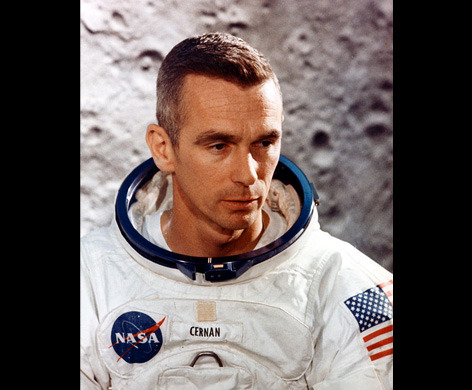
If you’d like to listen to the audio file, it is available HERE (starting at 2:50).
The full transcript is available HERE.
Make sure to follow us on Tumblr for your regular dose of space: http://nasa.tumblr.com
A Tour of our Moon
Want to go to the Moon?
Let our Lunar Reconnaissance Orbiter take you there!

Our lunar orbiter, also known as LRO, has been collecting data on lunar topography, temperature, resources, solar radiation, and geology since it launched nine years ago. Our latest collection of this data is now in 4K resolution. This updated "Tour of the Moon" takes you on a virtual tour of our nearest neighbor in space, with new science updates from the vastly expanded data trove.
Orientale Basin

First stop, Orientale Basin located on the rim of the western nearside. It's about the size of Texas and is the best-preserved impact structure on the Moon. Topography data from LRO combined with gravity measurements from our twin GRAIL spacecraft reveal the structure below the surface and help us understand the geologic consequences of large impacts.
South-Pole and Shackleton Crater

Unlike Earth, the Moon's axis is barely tilted relative to the Sun. This means that there are craters at the poles where the sunlight never reaches, called permanently shadowed regions. As a result, the Moon's South Pole has some of the coldest measured places in the solar system. How cold? -410 degrees F.
Because these craters are so cold and dark, water that happens to find its way into them never has the opportunity to evaporate. Several of the instruments on LRO have found evidence of water ice, which you can see in the highlighted spots in this visualization.
South-Pole Aitken Basin

South Pole-Aitken Basin is the Moon's largest, deepest and oldest observed impact structure. Its diameter is about 2,200 km or 1,367 miles across and takes up 1/4 of the Moon! If there was a flat, straight road and you were driving 60 mph, it would take you about 22 hours to drive across. And the basin is so deep that nearly two Mount Everests stacked on each other would fit from the bottom of the basin to the rim. South-Pole Aitken Basin is a top choice for a landing site on the far side of the Moon.
Tycho Crater

Now let's go to the near side. Tycho Crater is 100 million years young. Yes, that's young in geologic time. The central peak of the impact crater likely formed from material that rebounded back up after being compressed in the impact, almost like a spring. Check out that boulder on top. It looks small in this image, but it could fill a baseball stadium.
Aristarchus Plateau

Also prominent on the nearside is the Aristarchus Plateau. It features a crater so bright that you could see it with your naked eye from Earth! The Aristarchus Plateau is particularly interesting to our scientists because it reveals much of the Moon's volcanic history. The region is covered in rocks from volcanic eruptions and the large river-like structure is actually a channel made from a long-ago lava flow.
Apollo 17 Landing Site
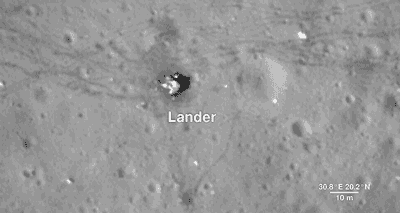
As much as we study the Moon looking for sites to visit, we also look back at places we've already been. This is because the new data that LRO is gathering helps us reinterpret the geology of familiar places, giving scientists a better understanding of the sequence of events in early lunar history.
Here, we descend to the Apollo 17 landing site in the Taurus-Littrow valley, which is deeper than the Grand Canyon. The LRO camera is even able to capture a view of the bottom half of the Apollo 17 Lunar Lander, which still sits on the surface, as well as the rover vehicle. These images help preserve our accomplishment of human exploration on the Moon's surface.
North Pole

Finally, we reach the North Pole. Like the South Pole, there are areas that are in permanent shadow and others that bask in nearly perpetual light. LRO scientists have taken detailed brightness and terrain measurements of the North Pole in order to model these areas of sunlight and shadow through time. Sunlit peaks and crater rims here may be ideal locations for generating solar power for future expeditions to the Moon.
LRO was designed as a one-year mission. Now in its ninth year, the spacecraft and the data emphasize the power of long-term data collection. Thanks to its many orbits around the Moon, we have been able to expand on lunar science from the Apollo missions while paving the way for future lunar exploration. And as the mission continues to gather data, it will provide us with many more opportunities to take a tour of our Moon.
And HERE's the full “Tour of the Moon” video:
We hope you enjoyed the tour. If you'd like to explore the moon further, please visit moon.nasa.gov and moontrek.jpl.nasa.gov.
Make sure to follow @NASAMoon on Twitter for the latest lunar updates and photos.
Make sure to follow us on Tumblr for your regular dose of space: http://nasa.tumblr.com
When Dead Stars Collide!
Gravity has been making waves - literally. Earlier this month, the Nobel Prize in Physics was awarded for the first direct detection of gravitational waves two years ago. But astronomers just announced another huge advance in the field of gravitational waves - for the first time, we’ve observed light and gravitational waves from the same source.

There was a pair of orbiting neutron stars in a galaxy (called NGC 4993). Neutron stars are the crushed leftover cores of massive stars (stars more than 8 times the mass of our sun) that long ago exploded as supernovas. There are many such pairs of binaries in this galaxy, and in all the galaxies we can see, but something special was about to happen to this particular pair.

Each time these neutron stars orbited, they would lose a teeny bit of gravitational energy to gravitational waves. Gravitational waves are disturbances in space-time - the very fabric of the universe - that travel at the speed of light. The waves are emitted by any mass that is changing speed or direction, like this pair of orbiting neutron stars. However, the gravitational waves are very faint unless the neutron stars are very close and orbiting around each other very fast.

As luck would have it, the teeny energy loss caused the two neutron stars to get a teeny bit closer to each other and orbit a teeny bit faster. After hundreds of millions of years, all those teeny bits added up, and the neutron stars were *very* close. So close that … BOOM! … they collided. And we witnessed it on Earth on August 17, 2017.

Credit: National Science Foundation/LIGO/Sonoma State University/A. Simonnet
A couple of very cool things happened in that collision - and we expect they happen in all such neutron star collisions. Just before the neutron stars collided, the gravitational waves were strong enough and at just the right frequency that the National Science Foundation (NSF)’s Laser Interferometer Gravitational-Wave Observatory (LIGO) and European Gravitational Observatory’s Virgo could detect them. Just after the collision, those waves quickly faded out because there are no longer two things orbiting around each other!
LIGO is a ground-based detector waiting for gravitational waves to pass through its facilities on Earth. When it is active, it can detect them from almost anywhere in space.

The other thing that happened was what we call a gamma-ray burst. When they get very close, the neutron stars break apart and create a spectacular, but short, explosion. For a couple of seconds, our Fermi Gamma-ray Telescope saw gamma-rays from that explosion. Fermi’s Gamma-ray Burst Monitor is one of our eyes on the sky, looking out for such bursts of gamma-rays that scientists want to catch as soon as they’re happening.
And those gamma-rays came just 1.7 seconds after the gravitational wave signal. The galaxy this occurred in is 130 million light-years away, so the light and gravitational waves were traveling for 130 million years before we detected them.

After that initial burst of gamma-rays, the debris from the explosion continued to glow, fading as it expanded outward. Our Swift, Hubble, Chandra and Spitzer telescopes, along with a number of ground-based observers, were poised to look at this afterglow from the explosion in ultraviolet, optical, X-ray and infrared light. Such coordination between satellites is something that we’ve been doing with our international partners for decades, so we catch events like this one as quickly as possible and in as many wavelengths as possible.

Astronomers have thought that neutron star mergers were the cause of one type of gamma-ray burst - a short gamma-ray burst, like the one they observed on August 17. It wasn’t until we could combine the data from our satellites with the information from LIGO/Virgo that we could confirm this directly.

This event begins a new chapter in astronomy. For centuries, light was the only way we could learn about our universe. Now, we’ve opened up a whole new window into the study of neutron stars and black holes. This means we can see things we could not detect before.

The first LIGO detection was of a pair of merging black holes. Mergers like that may be happening as often as once a month across the universe, but they do not produce much light because there’s little to nothing left around the black hole to emit light. In that case, gravitational waves were the only way to detect the merger.

Image Credit: LIGO/Caltech/MIT/Sonoma State (Aurore Simonnet)
The neutron star merger, though, has plenty of material to emit light. By combining different kinds of light with gravitational waves, we are learning how matter behaves in the most extreme environments. We are learning more about how the gravitational wave information fits with what we already know from light - and in the process we’re solving some long-standing mysteries!
Want to know more? Get more information HERE.
Make sure to follow us on Tumblr for your regular dose of space: http://nasa.tumblr.com
-
 pinklola9 liked this · 8 years ago
pinklola9 liked this · 8 years ago -
 hcolainenpoika liked this · 8 years ago
hcolainenpoika liked this · 8 years ago -
 armani-the-catus liked this · 8 years ago
armani-the-catus liked this · 8 years ago -
 grecia-m liked this · 8 years ago
grecia-m liked this · 8 years ago -
 snow-town-blog1 liked this · 8 years ago
snow-town-blog1 liked this · 8 years ago -
 best-hotels-posts reblogged this · 8 years ago
best-hotels-posts reblogged this · 8 years ago -
 mau-mau03 liked this · 8 years ago
mau-mau03 liked this · 8 years ago -
 fuckingdepressiveprincess reblogged this · 8 years ago
fuckingdepressiveprincess reblogged this · 8 years ago -
 brsndo liked this · 8 years ago
brsndo liked this · 8 years ago -
 chame-lionsoul liked this · 8 years ago
chame-lionsoul liked this · 8 years ago -
 kinkyfinky12-blog liked this · 8 years ago
kinkyfinky12-blog liked this · 8 years ago -
 30133782jb-blog liked this · 8 years ago
30133782jb-blog liked this · 8 years ago -
 01-08-21 liked this · 8 years ago
01-08-21 liked this · 8 years ago -
 opheliacaulfield reblogged this · 8 years ago
opheliacaulfield reblogged this · 8 years ago -
 sneakygoomba reblogged this · 8 years ago
sneakygoomba reblogged this · 8 years ago -
 instantlyvirtualstudent-fan liked this · 8 years ago
instantlyvirtualstudent-fan liked this · 8 years ago -
 moltensappho liked this · 8 years ago
moltensappho liked this · 8 years ago -
 everythng-you-are liked this · 8 years ago
everythng-you-are liked this · 8 years ago -
 frenchpuppycormier liked this · 8 years ago
frenchpuppycormier liked this · 8 years ago -
 xxkaonashixx reblogged this · 8 years ago
xxkaonashixx reblogged this · 8 years ago -
 sodiesoso reblogged this · 8 years ago
sodiesoso reblogged this · 8 years ago -
 bubble-beetle liked this · 8 years ago
bubble-beetle liked this · 8 years ago -
 urdejavu reblogged this · 8 years ago
urdejavu reblogged this · 8 years ago -
 chocolate-------------c liked this · 8 years ago
chocolate-------------c liked this · 8 years ago -
 paradisefarms808-blog liked this · 8 years ago
paradisefarms808-blog liked this · 8 years ago -
 marimo-green reblogged this · 8 years ago
marimo-green reblogged this · 8 years ago -
 marimo-green liked this · 8 years ago
marimo-green liked this · 8 years ago -
 hslt69 liked this · 8 years ago
hslt69 liked this · 8 years ago -
 bunjiking-blog liked this · 8 years ago
bunjiking-blog liked this · 8 years ago -
 shuaixiaohu liked this · 8 years ago
shuaixiaohu liked this · 8 years ago -
 furiousrebelmoon liked this · 8 years ago
furiousrebelmoon liked this · 8 years ago -
 megapao4 liked this · 8 years ago
megapao4 liked this · 8 years ago -
 seasnek liked this · 8 years ago
seasnek liked this · 8 years ago -
 transcendentalnature liked this · 8 years ago
transcendentalnature liked this · 8 years ago -
 myobsessionsandthings liked this · 8 years ago
myobsessionsandthings liked this · 8 years ago -
 enbygems liked this · 8 years ago
enbygems liked this · 8 years ago
Explore the universe and discover our home planet with the official NASA Tumblr account
1K posts